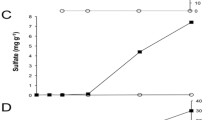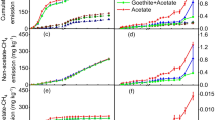Abstract
The effect of soil microbial processes on production and/or consumption of atmospheric trace gases was studied in four different soils which were preincubated in the presence of elevated concentrations of CH4, NH +4 or CO, to simulate the growth of the resident populations of methanotrophic, nitrifying, or carboxydotrophic bacteria, respectively. Oxidation of CH4, both at atmospheric (1.8 ppmv) and at elevated (3500 ppmv) CH4 mixing ratios, was stimulated after preincubation with CH4, but not with NH +4 or CO, indicating that CH4 was oxidized by methanotrophic, but not by nitrifying or carboxydotrophic bacteria. However, the oxidation of CH4 was partially inhibited by addition of NH +4 and CO. Analogously, oxidation of NH +4 was partially inhibited by addition of CH4. Oxidation of CO at elevated mixing ratios (2300 ppmv) was stimulated after preincubation with CO, indicating oxidation by carboxydotrophs, but was also stimulated at a small extent after preincubation with CH4, suggesting the involvement of methanotrophs. At atmospheric CO mixing ratios (0.13 ppmv), on the other hand, oxidation of CO was stimulated after preincubation with NH +4 , indicating that the activity was due to nitrifiers. NO uptake was stimulated in soils preincubated with CH4, indicating the involvement of methanotrophs. However, production of N2O was only stimulated, if CH4 was added as a substrate. The results indicate that especially the methanotrophic and nitrifying populations in soil not only oxidize their specific substrates, but are also involved in the metabolism of other compounds.
Similar content being viewed by others
References
Anthony C (1986) Bacterial oxidation of methane and methanol. Adv. Microb. Physiol. 27: 113–210
Baumgärtner M & Conrad R (1992) Effects of soil variables and season on the production and consumption of nitric oxide in oxic soils. Biol. Fertil. Soils 14: 166–174
Bedard C & Knowles R (1989) Physiology, biochemistry, and specific inhibitors of CH4, NH +4 , and CO oxidation by methanotrophs and nitrifiers. Microbiol. Rev. 53: 68–84
Bender M & Conrad R (1992) Kinetics of CH4 oxidation in oxic soils exposed to ambient air or high CH4 mixing ratios. FEMS Microbiol. Ecol. 101: 261–270
Berg P & Rosswall T (1985) Ammonium oxidizer numbers, potential and actual oxidation rates in two Swedish arable soils. Biol. Fertil. Soils 1: 131–140
Carlsen HN, Joergensen L & Degn H (1991) Inhibition by ammonia of methane utilization inMethylococcus capsulatus (Bath). Appl. Microbiol. Biotechnol. 35: 124–127
Cicerone RJ & Oremland RS (1988) Biogeochemical aspects of atmospheric methane. Global Biogeochem. Cycles 2: 299–327
Conrad R (1988) Biogeochemistry and ecophysiology of atmospheric CO and H2. Adv. Microb. Ecol. 10: 231–283
Conrad R (1990) Flux of NO x between soil and atmosphere: Importance and soil microbial metabolism. In: Revsbech NP & Soerensen J (Eds) Denitrification in Soil and Sediment (pp 105–128). Plenum, New York
Conrad R & Seiler W (1980) Field measurements of the loss of fertilizer nitrogen into the atmosphere as nitrous oxide. Atmos. Environ. 14: 555–558
Conrad R & Seiler W (1982) Utilization of traces of carbon monoxide by aerobic oligotrophic microorganisms in ocean, lake and soil. Arch. Microbiol. 132: 41–46
Dalton H (1977) Ammonia oxidation by the methane oxidising bacteriumMethylococcus capsulatus strain Bath. Arch. Microbiol. 114: 273–279
Davidson EA (1991) Fluxes of nitrous oxide and nitric oxide from terrestrial ecosystems. In: Rogers JE & Whitman WB (Eds) Microbial Production and Consumption of Greenhouse Gases: Methane, Nitrogen Oxides, and Halomethanes (pp 219–235). American Society for Microbiology, Washington DC
Dixon WJ (1953) Processing data for outliers. Biometrics 9: 74–89
Ferenci T, Stroem T & Quayle JR (1975) Oxidation of carbon monoxide and methane byPseudomonas methanica. J. Gen. Microbiol. 91: 79–91
Hutton WE & ZoBell CE (1953) Production of nitrite from ammonia by methane-oxidizing bacteria. J. Bacteriol. 65: 216–219
Hyman MR & Wood PM (1983) Methane oxidation byNitrosomonas europaea. Biochem. J. 212: 31–37
Jones RD & Morita RY (1983a) Methane oxidation byNitrosococcus oceanus andNitrosomonas europaea. Appl. Environ. Microbiol. 45: 401–410
Jones RD & Morita RY (1983b) Carbon monoxide oxidation by chemolithotrophic ammonium oxidizers. Can. J. Microbiol. 29: 1545–1551
Jones RD & Morita RY (1984) Effect of several nitrification inhibitors on carbon monoxide and methane oxidation by ammonium oxidizers. Can. J. Microbiol. 30: 1276–1279
Khalil MAK & Rasmussen RA (1992) The global sources of nitrous oxide. J. Geophys. Res. 97: 14651–14660
King GM (1992) Ecological aspects of methane oxidation, a key determinant of global methane dynamics. Adv. Microb. Ecol. 12: 431–468
Knowles R & Topp E (1988) Some factors affecting nitrification and the production of nitrous oxide by the methanotrophic bacteriumMethylosinus trichosporium OB3b. In: Giovannozzi-Sermanni G & Nannipieri P (Eds) Current Perspectives in Environmental Biogeochemistry (pp 383–393). C.N.R.-I.P.R.A., Roma
Krämer M, Baumgärtner M, Bender M & Conrad R (1990) Consumption of NO by methanotrophic bacteria in pure culture and in soil. FEMS Microbiol. Ecol. 73: 345–350
Lord E (1947) The use of range in place of standard deviation in thet-test. Biometrica 34: 41–67
McCarty GW & Bremner JM (1991) Inhibition of nitrification in soil by gaseous hydrocarbons. Biol. Fertil. Soils 11: 231–233
Megraw SR & Knowles R (1987) Active methanotrophs suppress nitrification in a humisol. Biol. Fertil. Soils 4: 205–212
Megraw SR & Knowles R (1989a) Methane-dependent nitrate production by a microbial consortium enriched from a cultivated humisol. FEMS Microbiol. Ecol. 62: 359–366
Megraw SR & Knowles R (1989b) Isolation, characterization, and nitrification potential of a methylotroph and two heterotrophic bacteria from a consortium showing methanedependent nitrification. FEMS Microbiol. Ecol. 62: 367–374
Meyer O (1985) Metabolism of aerobic carbon monoxide-utilizing bacteria. In: Poole RK & Dowdemic CS(Eds) Microbial Gas Metabolism. Mechanistic, Metabolic and Biotechnological Aspects (pp 131–151). Academic Press, London
Meyer O, Frunzke K & Mörsdorf G (1993) Biochemistry of the aerobic utilization of carbon monoxide. In: Murrell JC & Kelly DP(Eds) Microbial Growth on Cl Compounds (pp 433–459). Intercept, Andover
Morgan MF (1930) A simple spot-plate test for nitrate nitrogen in soil and other extracts. Science 71: 343–344
Mörsdorf G, Frunzke K, Gadkari D & Meyer O (1992) Microbial growth on carbon monoxide. Biodeg. 3: 61–82
Mosier A, Schimel D, Valentine D, Bronson K & Parton W (1991) Methane and nitrous oxide fluxes in native, fertilized and cultivated grasslands. Nature 350: 330–332
Remde A, Slemr F & Conrad R (1989) Microbial production and uptake of nitric oxide in soil. FEMS Microbiol. Ecol. 62: 221–230
Rowe R, Todd R & Waide J (1977) Microtechnique for most-probable-number analysis. Appl. Environ. Microbiol. 33: 675–680
Saad OALO & Conrad R (1993) Temperature dependence of nitrification, denitrification, and turnover of nitric oxide in different soils. Biol. Fertil. Soils 15: 21–27
Schlegel HG, Kaltwasser H & Gottschalk G (1961) Ein Submersverfahren zur Kultur wasserstoffoxidierender Bakterien: Wachstums-physiologische Untersuchungen. Arch. Mikrobiol. 38: 209–222
Schuster M & Conrad R (1992) Metabolism of nitric oxide and nitrous oxide during nitrification and denitrification in soil at different incubation conditions. FEMS Microbiol. Ecol. 101: 133–143
Seiler W & Conrad R (1987) Contribution of tropical ecosystems to the global budgets of trace gases, especially CH4, H2 CO and N2O. In: Dickinson RE (Ed) The Geophysiology of Amazonia (pp 133–162). Wiley, New York
Steudler PA, Bowden RD, Melillo JM & Aber JD (1989) Influence of nitrogen fertilization on methane uptake in temperate forest soils. Nature 341: 314–316
Ward BB (1987) Kinetic studies on ammonia and methane oxidation byNitrosococcus oceanus. Arch. Microbiol. 147: 126–133
Ward BB (1990) Kinetics of ammonia oxidation by a marine nitrifying bacterium: methane as a substrate analogue. Microb. Ecol. 19: 211–225
Whittenbury R, Phillips KC & Wilkinson JF (1970) Enrichment, isolation and some properties of methane-utilizing bacteria. J. Gen. Microbiol. 61: 205–218
Wood PM (1988) Methanisms for biological ammonia oxidation. In: Cole JA & Ferguson S (Eds) The Nitrogen and Sulphur Cycles (pp 219–243). Cambridge University Press, Cambridge
Yoshinari T (1985) Nitrite and nitrous oxide production byMethylosinus trichosporium. Can. J. Microbiol. 31: 139–144
Author information
Authors and Affiliations
Rights and permissions
About this article
Cite this article
Bender, M., Conrad, R. Microbial oxidation of methane, ammonium and carbon monoxide, and turnover of nitrous oxide and nitric oxide in soils. Biogeochemistry 27, 97–112 (1994). https://doi.org/10.1007/BF00002813
Received:
Accepted:
Issue Date:
DOI: https://doi.org/10.1007/BF00002813




